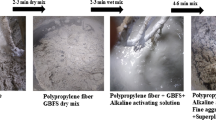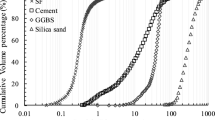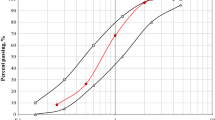Abstract
In this study, different engineered cementitious composite (ECC) designs were proposed with ground granulated blast slag (GGBS) combined with metakaolin (MK), micro silica (MS), and carbon nanotube (CNT) reinforced with polyvinyl alcohol (PVA) and polypropylene (PP) fibers. The specimens were cured in water, magnesium sulfate solution and exposed to freeze–thaw cycles to test the specimens' durability. Then, compressive strength, displacement in the middle of span, residual strength, and modulus of rupture of the specimens in different environments were compared. The results indicated that addition of MK had a significant effect on the reduction of permeability. Moreover, replacement of PP fibers with PVA fibers decreased the strength and increased the porosity of the specimens. It was found that the specimen containing 0.015% CNT had better performance compared to other samples. The results of samples cured in aggressive environments indicated that the specimen containing 0.015% CNT had the lowest loss in the value of compressive strength, modulus of rupture, displacement and residual strength in comparison to other mixtures. Furthermore, the use of CNT along with PVA fibers in ECC significantly increased the energy absorption capacity, indicating the CNT's ability to bridge and close the micro-cracks in a case of suitable distribution.








Similar content being viewed by others
References
Afroughsabet, V., Biolzi, L., & Ozbakkaloglu, T. (2016). High-performance fiber-reinforced concrete: a review. Journal of Materials Science, 51(14), 6517–6551.
Alyami, M. H., et al. (2019). Potential accelerated test methods for physical sulfate attack on concrete. Construction and Building Materials, 229, 116920.
Aslani, F., Wang, L., and Zheng, M. (2019) The effect of carbon nanofibers on fresh and mechanical properties of lightweight engineered cementitious composite using hollow glass microspheres. Journal of Composite Materials, p. 0021998319827078.
Aveston, J., (1972) Single and multiple fracture. The properties of fiber composites, p. 15–26.
Bagheri, S. M., et al. (2020). Evaluation of environment and economy viable recycling cement kiln dust for use in green concrete. Journal of Building Engineering, 32, 101809.
Bolhassani, M., & Samani, M. (2015). Effect of type, size, and dosage of nanosilica and microsilica on properties of cement paste and mortar. ACI Materials Journal, 112(2), 259–266.
Cherkashin, A. V., et al. (2017). Mechanical properties of nanocarbon modified cement. Magazine of Civil Engineering, 72(4), 54–61.
Fischer, G., Shuxin, W. (2003). Design of engineered cementitious composites (ECC) for processing and workability requirements, in Brittle Matrix Composites 7. 2003, Elsevier. p. 29–36.
Geng, X.J., Hou, F.F. (2017). Effects of curing time on micro properties of high-volume fly ash concrete with HCSA expansive agent, in Key Engineering Materials. p. 87–91.
Kewalramani, M.A., Ahmed, M.O., Imam Syed, Z. (2017). Engineered cementitious composites for modern civil engineering structures in hot arid coastal climatic conditions.
Koushkbaghi, M., et al. (2019). Acid resistance and durability properties of steel fiber-reinforced concrete incorporating rice husk ash and recycled aggregate. Construction and Building Materials, 202, 266–275.
Krenchel, H., & Stang, H. (1988). Stable microcracking in cementitious materials. Brittle Matrix Composites, 2, 20–33.
Li, V. C. (1993). From micromechanics to structural engineering. Doboku Gakkai Ronbunshu, 1993(471), 1–12.
Li, V. C., & Kanda, T. (1998). Innovations forum: engineered cementitious composites for structural applications. Journal of Materials in Civil Engineering, 10(2), 66–69.
Mansoori, A., & Behfarnia, K. (2020). Evaluation of the effects of nanomaterials on durability of engineered cementitious composites exposed to the aggressive environment. Journal of Composite Materials, 54(14), 1807–1817.
Meng, D., Lee, C., & Zhang, Y. (2019). Flexural fatigue properties of a polyvinyl alcohol-engineered cementitious composite. Magazine of Concrete Research, 71(21), 1130–1141.
Moharana, S. and Garg, B. (2017). Monitoring and detection of damage in cement composite under sulphate attack. in Life-Cycle of Engineering Systems: emphasis on Sustainable Civil Infrastructure—5th International Symposium on Life-Cycle Engineering, IALCCE 2016.
Mohseni, E., et al. (2017). Engineering and microstructural assessment of fibre-reinforced self-compacting concrete containing recycled coarse aggregate. Journal of Cleaner Production, 168(Supplement C), 605–613.
Mohseni, E., Tang, W., & Cui, H. (2017). Chloride diffusion and acid resistance of concrete containing zeolite and tuff as partial replacements of cement and sand. Materials, 10(4), 372.
Qian, C., Nie, Y., & Cao, T. (2016). Sulphate attack-induced damage and micro-mechanical properties of concrete characterized by nano-indentation coupled with X-ray computed tomography. Structural Concrete, 17(1), 96–104.
Ramezanianpour, A.M. (2012). Sulfate Resistance and Properties of Portland-Limestone Cements.
Şahmaran, M., et al. (2012). Frost resistance and microstructure of engineered cementitious composites: influence of fly ash and micro poly-vinyl-alcohol fiber. Cement and Concrete Composites, 34(2), 156–165.
Sedaghatdoost, A., & Behfarnia, K. (2018). Mechanical properties of Portland cement mortar containing multi-walled carbon nanotubes at elevated temperatures. Construction and Building Materials, 176, 482–489.
Shen, Y., et al. (2019). Experimental investigation on the freeze–thaw durability of concrete under compressive load and with joints. Construction and Building Materials, 229, 116893.
Wang, B., Han, Y., & Liu, S. (2013). Effect of highly dispersed carbon nanotubes on the flexural toughness of cement-based composites. Construction and Building Materials, 46, 8–12.
Yuan, F., Pan, J., & Leung, C. K. Y. (2017). Elastoplastic time history analysis of reinforced engineered cementitious composite or engineered cementitious composite-concrete composite frame under earthquake action. Advances in Structural Engineering, 20(4), 491–503.
Yücel, H. (2013). An alternative to conventional concrete overlay material: engineered Cementitious Composites (ECC). WIT Transactions on The Built Environment, 130, 771–782.
Zaroudi, M., Madandoust, R., & Aghaee, K. (2020). Fresh and hardened properties of an eco-friendly fiber reinforced self-consolidated concrete composed of polyolefin fiber and natural zeolite. Construction and Building Materials, 241, 118064.
Zhang, D., et al. (2019). Influence of stress damage and high temperature on the freeze–thaw resistance of concrete with fly ash as fine aggregate. Construction and Building Materials, 229, 116845.
Zhang, J., et al. (2014). Simulation of flexural performance of layered ECC-concrete composite beam with fracture mechanics model. Engineering Fracture Mechanics, 131, 419–438.
Zhang, Z., Qian, S., & Ma, H. (2014). Investigating mechanical properties and self-healing behavior of micro-cracked ECC with different volume of fly ash. Construction and Building Materials, 52, 17–23.
Author information
Authors and Affiliations
Corresponding author
Ethics declarations
Conflict of interest
On behalf of all authors, the corresponding author states that there is no conflict of interest.
Additional information
Publisher's Note
Springer Nature remains neutral with regard to jurisdictional claims in published maps and institutional affiliations.
Rights and permissions
About this article
Cite this article
Mansoori, A., Behfarnia, K. Evaluation of mechanical and durability properties of engineered cementitious composites exposed to sulfate attack and freeze–thaw cycle. Asian J Civ Eng 22, 417–429 (2021). https://doi.org/10.1007/s42107-020-00322-3
Received:
Accepted:
Published:
Issue Date:
DOI: https://doi.org/10.1007/s42107-020-00322-3




